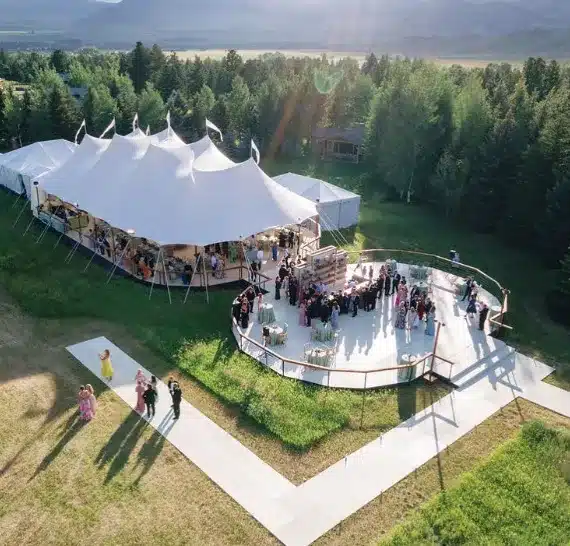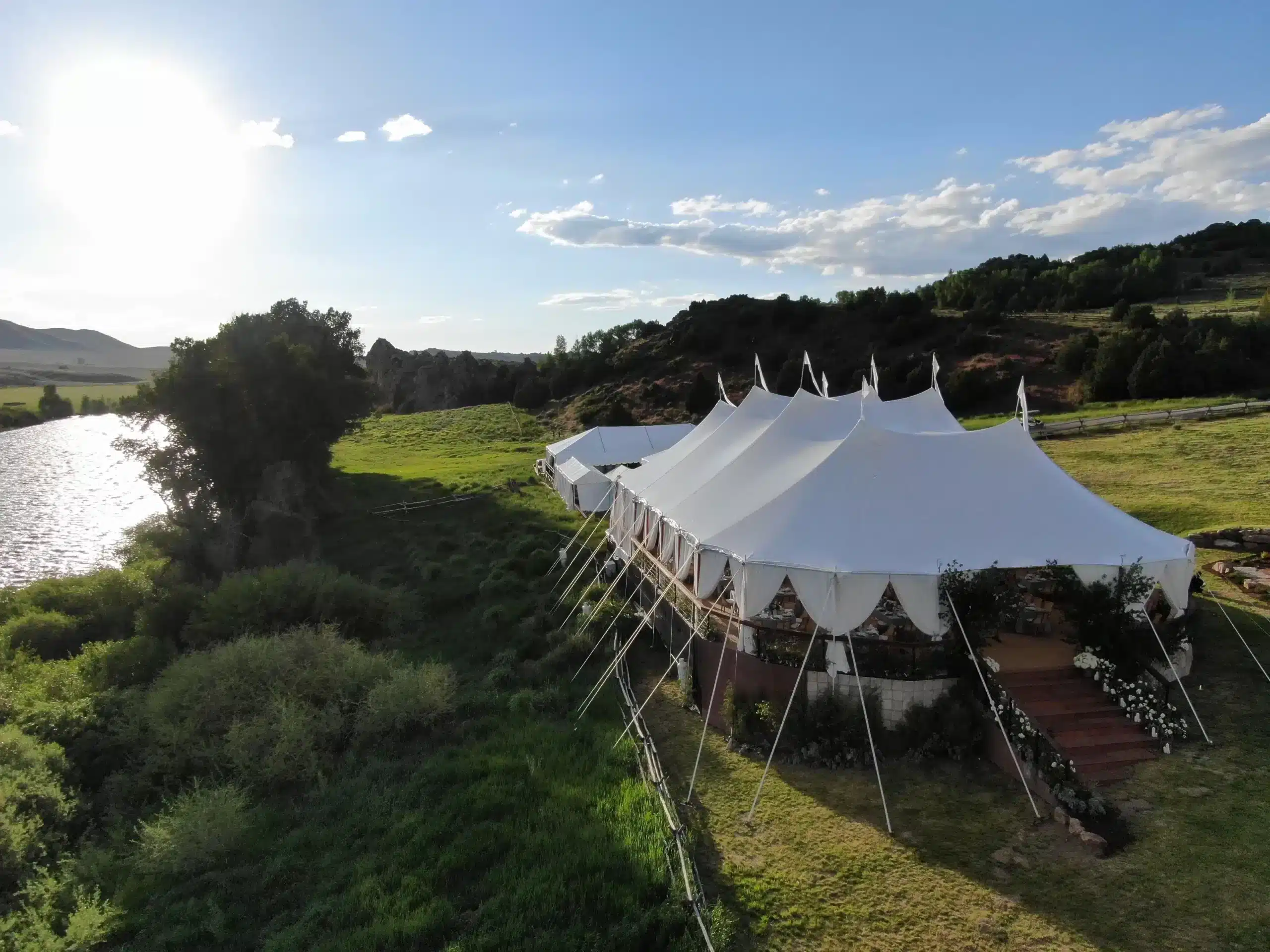Century pole tents are known for their elegant presence and towering structure—but like any outdoor setup, they’re vulnerable to wear, weather, and handling damage. Small issues can quickly escalate from torn fabric and broken poles to faulty zippers or seam splits if left unaddressed. Maintaining these tents is vital for long-term performance, guest safety, and visual impact. This guide walks through common damage types, DIY vs. professional repair decisions, and key maintenance strategies. Whether you’re prepping for a wedding, gala, or large outdoor celebration, the goal is to ensure your tent stays flawless from setup to takedown. Repairs don’t have to be overwhelming with the right tools and proactive care.
Key Takeaways
- Century pole tents can experience damage, including tears, pole breaks, seam issues, and zipper problems that compromise structural integrity.
- Effective repair methods range from DIY patching and adhesive sealing to complete pole replacement with specialized kits.
- Routine maintenance, proper storage, and timely professional inspections are essential to prevent future damage and extend the tent’s lifespan.
- Deciding between DIY and professional repair depends on the extent of damage, available tools, and desired longevity of the repair.
What Are the Most Common Types of Century Pole Tent Damage?

Century pole tents are built for durability, but regular use and environmental exposure can still cause wear and tear. The most common issues include fabric tears, pole dents or breaks, and seam or zipper failures. These damages can affect both the function and appearance of the tent. Identifying issues early can prevent further deterioration. Routine inspection and maintenance are essential to avoid costly event-day surprises. Spotting minor damage before it worsens makes repairs quicker and more affordable. Knowing what to look for helps extend the tent’s usable life.
Identifying Signs of Fabric Wear and Tear
Fabric issues often start small—like fraying at seams, tiny punctures, or discolored areas that weaken over time. These spots can expand under stress, especially during wind or rain exposure. Look for sagging fabric, irregular stretching, or fading that signals UV damage. Even light abrasion can evolve into a significant tear without treatment. Routine inspection after each use is essential to catch issues early. Focus on roof panels, tension points, and frequently handled sections. Keeping the fabric dry during storage helps prevent mildew-related weakening. Regular monitoring is the best defense.
Spotting Structural Damage in Tent Poles
Poles experience high stress during setup, exposure to wind, and repeated transport. Damage might include bending, hairline cracks, or misaligned connectors. Even slight deformation can lead to imbalance across the frame. Inspect each pole thoroughly for straightness and surface wear. Pay attention to rust or corrosion in humid areas, which can weaken the structure. Poles that wobble or fail to lock in place during setup are red flags. Routine inspection ensures the structural integrity needed for guest safety. Replace compromised poles before each major event.
Recognizing Zipper and Seam Failure
Seams and zippers can degrade due to frequent use and repeated exposure to tension and moisture. Fraying threads, gaping seams, or zippers that jam or come off track all signal emerging issues. These small failures can compromise wind protection or leak resistance. During setup and takedown, observe if seams pull apart or zippers resist movement. Keep zippers clean of dirt or grit to avoid accelerated wear. Spot-seal small seam gaps using fabric-safe adhesive to prevent further damage. Proactive care here avoids larger repairs later.
How Can You Repair Tears in Century Pole Tents Step-by-Step?

When fabric tears occur, a structured approach to repair ensures the tent regains its full protective function. Repairs should begin with a clean, dry surface and the correct patch materials. Proper alignment and adhesive application help create strong, weatherproof seals. Minor tears can be handled on-site, but larger repairs may require controlled conditions. Tools like rollers and clamps help ensure even pressure and bonding. With proper techniques, even high-stress areas can be restored effectively. Repaired tents should be inspected again before the next use to ensure reliability.
Cleaning and Preparing the Damaged Area
Before any repair begins, the area must be free of dirt, moisture, and oils that could prevent adhesion. Use a soft cloth with mild cleaner to wipe the surrounding fabric. Let the surface air-dry fully before applying any patch or adhesive. Trimming frayed edges helps the patch sit flush and reduces the chance of further unraveling. Mark the damaged zone clearly to guide placement. Avoid scrubbing too hard, which can expand the tear. Preparation ensures the materials bond securely and evenly. Skipping this step can shorten the repair’s lifespan.
Choosing the Right Patching Method
Repair patches come in adhesive-backed or glue-on formats and must match the tent’s material. Select a patch that extends at least an inch beyond the tear on all sides. Apply a thin, even layer of adhesive if needed and press the patch firmly in place. Smooth from the center outward to remove air bubbles. Use a roller tool for best results. Some fabric types may benefit from heat activation using a heat gun at low settings. Apply patches on both sides of large tears if possible. Always follow manufacturer curing guidelines.
Ensuring Long-Term Durability After Repair
Post-repair steps are essential to prevent re-tearing and to maintain waterproofing. After curing, inspect the patch for edge lift or bubbles. If needed, reinforce with a secondary adhesive layer. Consider applying a UV-protective spray over the repair area to prevent sun damage. Waterproofing treatment helps maintain the tent’s ability to shed water. Store the tent properly after the event to avoid folding stress along the repaired section. Keep repair logs to monitor repeated issues. A well-executed repair can extend a tent’s use by many events.
How to Replace or Repair Broken Poles in Century Pole Tents?

Pole damage poses immediate risks to safety and stability and should be addressed as soon as it’s detected. Repairs vary from reinforcing minor dents to full pole replacements using compatible hardware. Working with correct tools and methods ensures the repaired or replaced pole integrates with the entire tent frame. Always inspect other poles when one fails, as damage may not be isolated. Precision and alignment are key during repair to avoid tent imbalance. Consistent inspection, even between events, helps avoid unexpected failures. Secure and stable pole systems uphold the overall structure’s integrity.
Inspecting the Full Frame Before Repairs Begin
Start by carefully inspecting all poles for signs of wear, such as cracks, bends, or surface rust. Even small imperfections can signal a weakening structure, especially under high tension. Remove the damaged pole and check its fittings for compatibility. Look for signs of misalignment in the tent canopy or base plates, which often occur with pole damage. Use measuring tools to confirm proper lengths and angles for replacements. Take note of any additional parts showing stress. A full system check ensures a complete and effective repair. Never reuse severely bent or corroded poles.
Reinforcing or Replacing Tent Poles Safely
When the damage is minor, metal sleeves or epoxy-wrapped fiberglass may restore strength temporarily. For more significant fractures, replace the pole using parts matching the original specifications. Ensure the new pole fits securely into existing connectors and maintains proper tension. Use clamps or fasteners to hold components in place during installation. Never substitute makeshift materials, as they may fail under stress. Reinforced poles must still undergo stability checks. After installation, test the tent’s balance and fabric tension. Safety and alignment take priority over speed in pole replacement.
Testing Repaired Poles for Load and Balance
Once repairs are complete, stress-test the pole by gently applying tension through the tent canopy. Watch for shifting, creaking, or bending. Check all attachment points and connectors for gaps or movement. Assess the frame’s alignment across all poles to ensure even load distribution. Uneven balance can strain the fabric and cause failure under wind. Confirm that the repaired pole holds equal tension without flexing. Only after passing these checks should the tent be deemed ready for use. Post-repair inspection is vital for long-term structural safety.
What Are the Best Repair Materials and Tools for Century Pole Tent Damage?

Using reliable materials and tools is essential when restoring damaged Century Pole Tents. The right choices ensure repairs are strong, weather-resistant, and visually seamless. Whether repairing fabric tears, seams, or poles, the focus should be on durability and compatibility with commercial tent systems. Specialized repair kits, waterproof adhesives, UV-resistant coatings, and heavy-duty tools are often required. Select materials that bond well with treated fabric surfaces and withstand event-level stress. Always follow application instructions carefully to avoid rework or failure. The quality of tools and products directly affects the lifespan of the repair.
Choosing Heavy-Duty Repair Kits for Fabric Restoration
Highly rated repair kits for century pole tents include high-strength patches, UV-resistant adhesives, and seam sealants that ensure waterproof and durable repairs. Kits with dual-layer patches are especially popular for added strength and waterproofing in commercial settings. Reviews from professionals and event managers can help in selecting kits that comply with industry standards for commercial tents and roofs.
Tools That Improve Precision and Bond Strength
Essential tools include fabric scissors, seam rollers, and flexible adhesive applicators. For pole repairs, clamps, measuring tape, and epoxy mixers are needed. Heat guns and pressure applicators help ensure a tight, even bond. Non-slip gloves and protective eyewear support safe handling. Use roller tools to eliminate bubbles beneath adhesive layers. Precise cuts and accurate placement make a major difference in patch strength. Invest in tools designed specifically for event tents—not general camping gear. Precision helps the repair blend into the structure seamlessly while enhancing reliability.
Best Adhesives and Tapes for Long-Term Performance
Look for industrial adhesives that cure quickly and stay flexible under heat and pressure. Choose bonding agents that resist UV rays and moisture over time. Repair tapes should offer high tensile strength and retain adhesion on treated or coated fabrics. Compatibility with tent materials is crucial to prevent peeling or cracking. Avoid products with a glossy finish that may not blend well with matte tent fabric. Use a two-layer approach—adhesive followed by tape or sealant—for higher durability. Long-term performance depends on choosing adhesives and tapes made for commercial-grade use.
Should You Choose DIY or Professional Repair for Century Pole Tent Damage?

Deciding between do-it-yourself repairs and hiring professionals depends on the severity of the damage, budget, and event timeline. While minor issues like small tears or seam splits can be fixed with basic kits, structural damage often requires expert help. DIY methods are best suited for quick fixes before or after events. However, improper repairs can compromise safety or lead to repeat issues. Professional services typically ensure longer-lasting results with specialized tools and experienced techniques. Weigh the pros and cons based on urgency, complexity, and intended tent use. Safety and functionality should always be the priority.
When DIY Repairs Are Effective and Safe
DIY repairs work well for surface-level damage like fabric tears, seam frays, or loose zippers. With proper kits and instructions, these fixes can be completed quickly on-site or in between events. They’re especially useful for minor wear detected during setup or takedown. However, DIY repairs must still follow proper safety procedures and use correct tools. Test repaired sections under tension before reuse. Avoid makeshift fixes with household materials, as these don’t offer long-term durability. Keep extra patch kits in your gear for emergencies. Regular visual checks will help catch issues early enough for DIY solutions.
Risks of Improper Repairs and Short-Term Fixes
Untrained repairs, especially for poles or anchor points, can weaken the tent’s stability. Using the wrong materials may result in adhesive failure, water leaks, or fabric warping. Poorly done patches may tear again under wind or stress. Rushed repairs often miss hidden damage, leading to safety issues mid-event. Inconsistent fabric tension or structural imbalance can distort the tent’s appearance. Over time, repeated temporary fixes may cost more than one professional repair. It’s important to know when a quick patch won’t be enough. Prioritize safety if the tent is critical for a large or high-profile event.
When Professional Repairs Are the Better Option
Professional repair services are recommended when damage involves key structural parts like center poles, tension points, or base plates. Experts can evaluate the entire frame and detect wear that might be missed otherwise. They also use certified materials and tools tailored to commercial-grade tents. If your tent has been repaired multiple times, a full inspection may be needed to assess long-term reliability. Professionals can offer warranty-backed service and guarantee safety compliance. For large events, relying on skilled repair teams reduces risk and ensures the tent performs at full capacity. It’s a smart investment for peace of mind.
How to Maintain and Prevent Future Damage to Your Century Pole Tent?

Ongoing maintenance is the best defense against future tent damage. Routine cleaning, protective treatments, and careful handling extend the life of your tent while reducing costly repairs. Consistent storage practices and seasonal inspections help preserve the fabric and structure over time. Maintenance routines should include weatherproofing, tension checks, and inspection logs to track wear and tear. Avoid storing tents when damp or dirty, as this leads to mold and fabric deterioration. With proactive care, your century pole tent will remain reliable across multiple events. Prioritizing upkeep ensures both function and appearance are preserved year-round.
Cleaning and Storing Tents After Every Use
Always clean tents immediately after use to remove dirt, debris, or stains that can weaken fabric. Use soft brushes and mild detergents to avoid abrasion or chemical damage. Rinse thoroughly and allow complete drying before folding. Store the tent in a cool, dry, shaded space away from sharp objects or moisture-prone surfaces. Fold and pack according to manufacturer guidelines to avoid creases or strain points. Label storage bags with usage history for easy tracking. Regular post-event care prevents long-term fabric wear and mildew formation. Proper cleaning and storage habits are essential for tent longevity.
Preventive Maintenance for Poles, Anchors, and Fabric
Inspect structural components regularly for cracks, rust, or bending. Tighten connections and reapply protective coatings to prevent corrosion. Test pole stability and anchoring points before and after each use, especially after heavy wind or rain. Apply UV-blocking sprays to tent fabric and check seams for loosening. Reinforce known weak points with early patching to prevent large tears. Keep a maintenance checklist to stay consistent across events. Preventive care minimizes emergency repairs and extends usable life. Don’t wait for damage to appear—act early to maintain integrity.
Seasonal Waterproofing and Weatherproof Protection
Apply waterproofing solutions at least once per season or after significant rainfall exposure. Use commercial-grade sprays or roll-on sealants rated for tent fabric. Cover both interior and exterior seams for full protection. Also consider treatments that add UV resistance to reduce sun damage. Ensure waterproofing is applied in a well-ventilated space with proper drying time. Recheck treated areas for even coverage and durability. Weatherproofing reduces leaks, mildew, and sun-related wear. With regular application, your tent stays ready for unpredictable outdoor conditions.
Frequently Asked Questions
What immediate steps should be taken when damage is spotted on a century pole tent?
Start by performing a full inspection to assess the issue. For minor fabric damage or hardware issues, basic patch kits or on-site fixes may work. If structural elements like poles or seams are compromised, it’s best to pause setup and consult professionals. Skyline Tent Company’s crew performs damage checks during setup and takedown to catch problems early.
How can routine maintenance prevent future damage?
Regular cleaning, proper drying, and storing tents in controlled environments help preserve fabric quality. Preventive steps like inspecting poles, treating fabric for UV and water resistance, and addressing small issues promptly reduce long-term wear. Skyline Tent Company follows a maintenance routine that ensures tents remain event-ready between uses.
Is it advisable to repair a century pole tent if it has been previously damaged multiple times?
If a tent has been patched repeatedly, it may be time for a deeper inspection. Multiple repairs can indicate stress in the structure or fabric that compromises safety. At that point, professional evaluation is essential to determine whether continued use is safe or if components should be retired or replaced.
What role does professional repair play in the overall safety of large-scale events?
Professional repair ensures structural integrity, especially for high-capacity events. Experts use precise tools and materials that meet performance standards, minimizing the risk of collapse or water intrusion. Skyline Tent Company prioritizes safety by addressing even minor wear before each rental and deploying skilled teams for setup.
Can modern repair tapes and adhesives restore a century pole tent to its original performance levels?
Yes—when applied properly, industrial-grade adhesives and patching systems can fully restore waterproofing and flexibility. These materials are designed to match the performance characteristics of the original tent fabric. Skyline Tent Company uses commercial-grade products to maintain the durability and appearance of its tent inventory.
Conclusion
Skyline Tent Company emphasizes that maintaining century pole tents is crucial for safe and luxurious event execution. A comprehensive repair strategy—combining DIhniques with professional servicesY tec when necessary—helps address both cosmetic and structural damage effectively. With consistent preventive measures including regular inspections, proper cleaning, and high-quality repair materials, your tent will remain a reliable and impressive backdrop for high-profile events.

